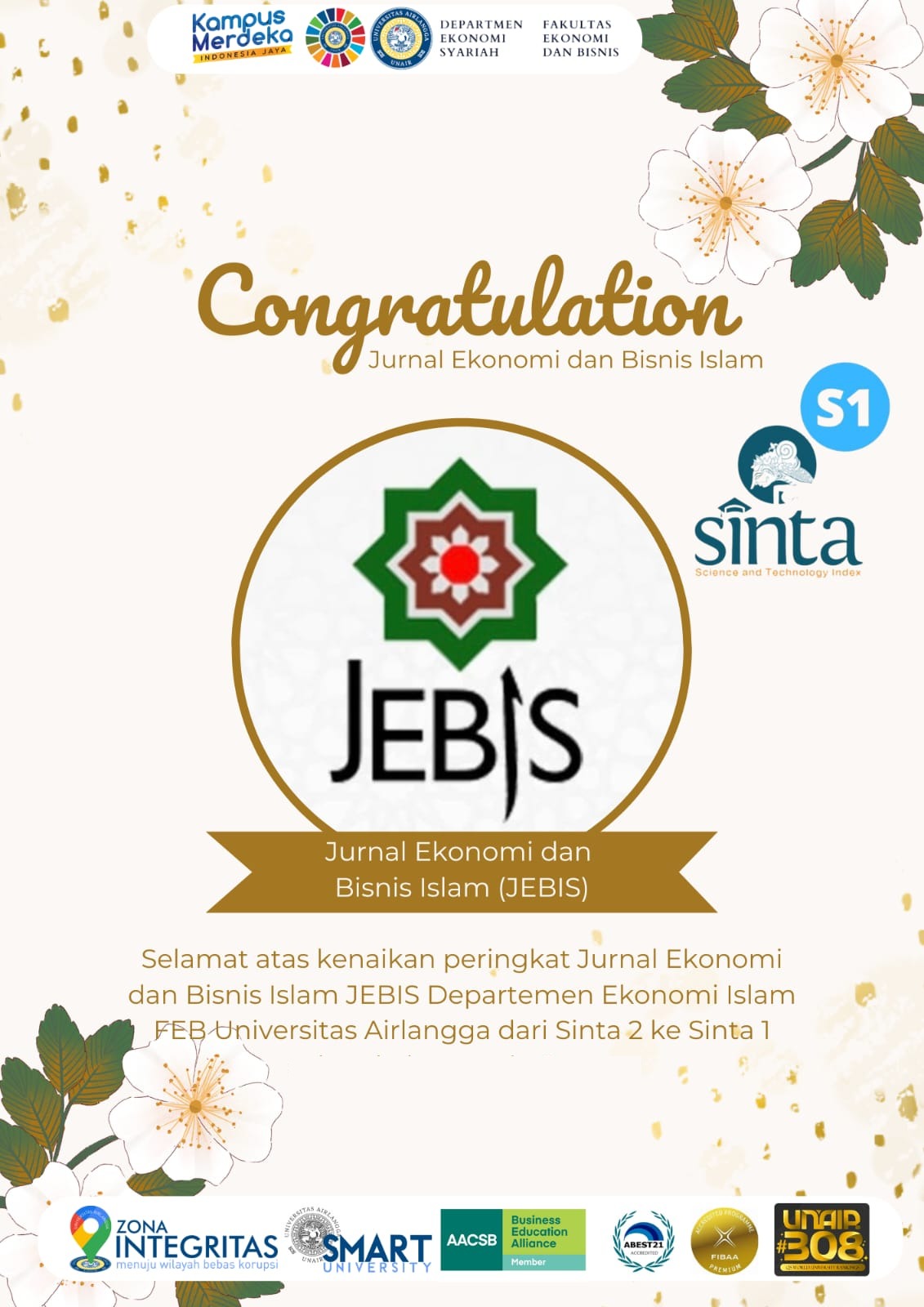ANALYSIS OF MACROECONOMIC FLUCTUATIONS IMPACT ON EFFICIENCY AND ISLAMIC BANKING QUALITY 2015-2019
Downloads
Akpan, M. N. U., Aik, N. C., Wanke, P. F., & Chau, W. H. (2018). Exploring the long-term trade-off between efficiency and value creation in horizontal M&As: Evidence from Nigeria. African Journal of Economic and Management Studies, 9(2), 130–147. https://doi.org/10.1108/AJEMS-06-2017-0139
Altunbas, Y., Liu, M. H., Molyneux, P., & Seth, R. (2000). Efficiency and risk in Japanese banking. Journal of Banking and Finance, 24(10), 1605–1628. https://doi.org/10.1016/S0378-4266(99)00095-3
Alwi, A. B. (2018). Pembiayaan Berbasis Teknologi Informasi (Fintech) yang Berdasarkan Syariah. Al-QÄnÅ«n, 21(2), 255–271.
Asteriou, D., & Hall, S. G. (2007). Applied Econometrics, A Modern Approach (Revised Edition). Palgrave Macmillan.
Aulia, M., Yustiardhi, A. F., & Permatasari, R. O. (2020). An overview of Indonesian regulatory framework on Islamic financial technology (fintech). Jurnal Ekonomi & Keuangan Islam, 6(1), 64–75. https://doi.org/10.20885/jeki.vol6.iss1.art7
Bank Indonesia. (2011). Peraturan Bank Indonesia Nomor: 13/1/PBI/2011 Tentang Penilaian Tingkat Kesehatan Bank Umum. Peraturan Bank Indonesia, 1–31.
Beck, T., Demirgüç-Kunt, A., & Merrouche, O. (2013). Islamic vs. conventional banking: Business model, efficiency and stability. Journal of Banking and Finance, 37(2), 433–447. https://doi.org/10.1016/j.jbankfin.2012.09.016
Chitnis, A., & Vaidya, O. S. (2018). Efficiency ranking method using SFA and TOPSIS (ERM-ST): case of Indian banks. Benchmarking, 25(2), 471–488. https://doi.org/10.1108/BIJ-08-2016-0126
Cucinelli, D. (2016). Can speed kill?: The cyclical effect of rapid credit growth: evidence from bank lending behavior in Italy. Journal of Risk Finance, 17(5), 562–584. https://doi.org/10.1108/JRF-03-2016-0035
Damanhur, Albra, W., Syamni, G., & Habibie, M. (2018). What is the Determinant of Non-Performing Financing in Branch Sharia Regional Bank in Indonesia. 1, 265–271. https://doi.org/10.1108/978-1-78756-793-1-00081
Dhal, S., & Misra, B. (2014). Pro-cyclical Management of Banks ' NonPerforming Loans by the Indian Public Sector Banks Pro-cyclical Management of Banks ' Non -Performing Loans by the Indian Public Sector Banks. RBI Occasional Papers, March, 1–23.
Ding, D., & Sickles, R. C. (2019). Capital Regulation, Efficiency, and Risk Taking: A Spatial Panel Analysis of US Banks. Panel Data Econometrics, 2, 405–466. https://doi.org/10.1016/b978-0-12-815859-3.00013-5
Effendi, J., Thiarany, U., & Nursyamsiah, T. (2017). Factors Influencing Non-Performing Financing (NPF) at Sharia Banking. Walisongo: Jurnal Penelitian Sosial Keagamaan, 25(1), 109–138. https://doi.org/10.21580/ws.25.1.1540
Fatmawati, A., Yudha, A. T. R. C., & Syafaq, H. (2020). Kontrak Kerja dan Kesejahteraan ABK Nelayan Perspektif Etika Bisnis Islam di Sarangmerduro, Jawa Tengah. Nukhbatul 'Ulum: Jurnal Bidang Kajian Islam, 6(2), 298–313.
Firianingsih, N. (2017). Analisis Perbandingan Efisiensi Bank Umum Syariah dan Bank Umum Konvensional dengan Metode Data Evelopment Analysis (DEA) periode 2010-2014. ВеÑтник РоÑздравнадзора.
Ghosh, A. (2017). Impact of non-performing loans on US product and labor markets. Journal of Financial Economic Policy, 9(3), 302–323. https://doi.org/10.1108/JFEP-01-2017-0003
Habibi, M. L., & Yudha, A. T. R. C. (2017). Membangun Integrated Takaful Dan Wakaf Model Dalam Upaya Meningkatkan Kemanfaatan Pemegang Polis. Al-Uqud : Journal of Islamic Economics, 1(2), 139. https://doi.org/10.26740/jie.v1n2.p139-155
Hadisumarto, W. B. M. C., & Ismail, A. G. B. (2010). Improving the effectiveness of Islamic micro-financing: Learning from BMT experience. Humanomics, 26(1), 65–75. https://doi.org/10.1108/08288661011025002
Haleem, A., & Khan, M. I. (2017). Towards successful adoption of Halal logistics and its implications for the stakeholders. British Food Journal, 119(7), 1592–1605. https://doi.org/10.1108/BFJ-12-2016-0637
Hardianto, D. S., & Wulandari, P. (2016). Islamic bank vs conventional bank: intermediation, fee based service activity and efficiency. International Journal of Islamic and Middle Eastern Finance and Management., 9(2), 296–311. https://doi.org/10.1108/IMEFM-01-2015-0003
Hassan, Y., & Sengupta, A. (2019). India – an untapped market for halal products. Journal of Islamic Marketing, 10(3), 981–1002. https://doi.org/10.1108/JIMA-09-2018-0179
Hazera, A., Quirvan, C., & Marin-Hernandez, S. (2016). The impact of guaranteed bailout assistance on bank loan overstatement: The Mexican financial crisis of the late 1990s and early 2000s. International Journal of Managerial Finance, 12(2), 177–210. https://doi.org/10.1108/IJMF-04-2014-0046
Hess, K., & Francis, G. (2004). Cost income ratio benchmarking in banking: A case study. Benchmarking, 11(3), 303–319. https://doi.org/10.1108/14635770410538772
Ilmu, L., & Indonesia, P. (2012). Dan Konvensional Di Indonesia Comparison Efficiency Analysis of Islamic and. 183–193.
Indrawati, S. M., Diop, N., Ikhsan, M., & Kacaribu, F. (2020). Enhancing Resilience to Turbulent Global Financial Markets: An Indonesian Experience. ... and Finance in Indonesia, 66(1), 47–63.
Isa, M. Y. M., & Rashid, M. Z. H. A. (2018). Regulatory capital funds and risk-sharing behavior in distressed financial conditions: An empirical analysis on Islamic banks in Malaysia. Journal of Financial Reporting and Accounting, 16(1), 197–216. https://doi.org/10.1108/JFRA-06-2015-0066
Lee, S. P., & Isa, M. (2017). Determinants of bank margins in a dual banking system. Managerial Finance, 43(6), 630–645. https://doi.org/10.1108/MF-07-2016-0189
Lotto, J. (2019). Evaluation of factors influencing bank operating efficiency in Tanzanian banking sector. Cogent Economics and Finance, 7(1). https://doi.org/10.1080/23322039.2019.1664192
Miah, M. D., & Uddin, H. (2017). Efficiency and stability: A comparative study between islamic and conventional banks in GCC countries. Future Business Journal, 3(2), 172–185. https://doi.org/10.1016/j.fbj.2017.11.001
Muljawan, D., Hafidz, J., Astuti, R. I., & Oktapiani, R. (2014). Faktor-Faktor Penentu Efisiensi Perbankan Indonesia serta Dampaknya terhadap Perhitungan Suku Bunga Kredit. Working Paper Bank Indonesia, WP/2/2014, 1–77.
Murti, T. W. (2017). Halal Life Style And Global Trade. The 7th International Seminar on Tropical Animal Production Contribution of Livestock Production on Food Sovereignty in Tropical Countries, 2, 33–39.
Nguyen, Q. T. T., Nguyen, S. T. B., & Nguyen, Q. V. (2019). Can Higher Capital Discipline Bank Risk: Evidence from a Meta-Analysis. Journal of Risk and Financial Management, 12(3), 134. https://doi.org/10.3390/jrfm12030134
Noman, A. H. M., Gee, C. S., & Isa, C. R. (2017). Does competition improve financial stability of the banking sector in ASEAN countries? An empirical analysis. PLoS ONE, 12(5), 1–27. https://doi.org/10.1371/journal.pone.0176546
Noordin, N. H., Haron, S. N., & Kassim, S. (2017). Developing a comprehensive performance measurement system for waqf institutions. International Journal of Social Economics, 44(7), 921–936. https://doi.org/10.1108/IJSE-09-2015-0257
Olson, D., & A. Zoubi, T. (2014). The determinants of loan loss and allowances for MENA banks: Simultaneous equation and three-stage approaches. Journal of Islamic Accounting and Business Research, 5(1), 98–120. https://doi.org/10.1108/JIABR-07-2013-0027
Pan, X., Dresner, M., & Xie, Y. (2019). Logistics IS resources, organizational factors, and operational performance: An investigation into domestic logistics firms in China. International Journal of Logistics Management, 30(2), 569–594. https://doi.org/10.1108/IJLM-02-2018-0023
Pham, T. P., Popesko, B., Quddus, A., & Nguyen, N. T. K. (2021). Innovation and Bank Efficiency in Vietnam and Pakistan. Scientific Papers of the University of Pardubice, Series D: Faculty of Economics and Administration, 29(2), 1–11. https://doi.org/10.46585/sp29021184
Phan, H. T. M., Daly, K., & Akhter, S. (2016). Bank efficiency in emerging Asian countries. Research in International Business and Finance, 38, 517–530. https://doi.org/10.1016/j.ribaf.2016.07.012.
Pinochet, L. H. C., Diogo, G. T., Lopes, E. L., Herrero, E., & Bueno, R. L. P. (2019). Propensity of contracting loans services from FinTech's in Brazil. International Journal of Bank Marketing, 37(5), 1190–1214. https://doi.org/10.1108/IJBM-07-2018-0174
Ponziani, R. M. , & Mariyanti, T. (2020). Islamic Bank and Monetary Policy: The Case of Indonesia. International Journal of Islamic Economics and Finance (IJIEF), 3(1), 121–142. https://doi.org/10.18196/ijief.2124
Prahasty, D. R., & Misdiyono. (2020). The Effects of Third Party Fund, Interest Rates, Bank Capital, and Non-Performing Loan towards Credit Dustribution on Commercial Bank in Indonesia period 2012-2018. International Journal of Advance Study and Research Work, 3(5), 22–29, (2581-5997). https://doi.org/10.5281/zenodo.3843656
Rabab'ah, M. (2015). Factors Affecting the Bank Credit: An Empirical Study on the Jordanian Commercial Banks. International Journal of Economics and Finance, 7(5), 166–178. https://doi.org/10.5539/ijef.v7n5p166
Rahmah, A. Z., & Armina, S. H. (2020). Macro and micro determinants of the non-performing finance: The case of Indonesian Islamic bank. Jurnal Ekonomi & Keuangan Islam, 6(1), 34–41. https://doi.org/10.20885/jeki.vol6.iss1.art4
Ramanathan, R., Ramanathan, U., & Bentley, Y. (2018). The debate on flexibility of environmental regulations, innovation capabilities and financial performance – A novel use of DEA. Omega (United Kingdom), 75, 131–138. https://doi.org/10.1016/j.omega.2017.02.006
Roy, A., & Goswami, C. (2013). A scientometric analysis of literature on performance assessment of microfinance institutions (1995-2010). International Journal of Commerce and Management, 23(2), 148–174. https://doi.org/10.1108/10569211311324939
Ryandono, M. N. H., & Ridlwan, A. A. (2020). Solution for Islamic Banks Exploitation: A Criticism of Fixed-Yields Based Financing in Indonesia. Al-Uqud: Journal of Islamic Economics, 4(1), 48–68. https://doi.org/10.26740/al-uqud.v4n1.p48-68
Sadari, S., & Hakim, A. (2019). Revitalisasi Keuangan Inklusif Dalam Sistem Perbankan Syariah Di Era Financial Technology. Journal of Islamic Economics, Finance, and Banking.
Åžan, T. (2016). The Effects of the Changes in Some Macroeconomic Indicators on the Non – Performing Loans in the Albanian Banking Sector (2007 – 2014). Mediterranean Journal of Social Sciences, 7(3), 162–170. https://doi.org/10.5901/mjss.2016.v7n3p162
Sukoco, A., Anshori, Y., & Yudha, A. T. R. C. (2020). Strategies To Increase Market Share For Histopatological Equipment Products (Brand Sakura): Case Study in Management of a Sole Agent Company. SINERGI , Volume 10 Number 2 September 2020 SINERGI , Volume 10 Number 2 September 2020, 10(2), 19–26.
Wardiwiyono, S. (2012). Internal control system for Islamic micro financing: An exploratory study of Baitul Maal wat Tamwil in the City of Yogyakarta Indonesia. International Journal of Islamic and Middle Eastern Finance and Management, 5(4), 340–352. https://doi.org/10.1108/17538391211282836
Yalina, N., Kartika, A. P., & Yudha, A. T. R. C. (2020). Impact Analysis of Digital Divide on Food Security and Poverty in Indonesiain 2015-2017. Jurnal Manajemen Teknologi, 19(2), 145–158. https://doi.org/http://dx.doi.org/10.12695/jmt.2020.19.2.3
Yin, Z., Yu, Y., & Huang, J. (2018). Evaluation and evolution of bank efficiency considering heterogeneity technology: An empirical study from China. PLoS ONE, 13(10), 1–19. https://doi.org/10.1371/journal.pone.0204559
Yudha, A. T. R. C., Pauzi, N. S., & Azli, R. binti M. (2020). The Synergy Model for Strengthening the Productivity of Indonesian Halal Industry. 4(28), 186–199. https://doi.org/10.26740/al-uqud.v4n2.p186-199
Yudha, A. T. R. C., Ryandono, M. N. H., Rijal, A., & Wijayanti, I. (2020). Financing model to develop local commodity business of East Java in Maqashid Syariah perspective. Test Engineering and Management, 83(3590), 3590–3595.
Zaki, I., Widiastuti, T., Yudha, A. T. R. C., Wijayanti, I., & Mi'raj, D. A. (2020). Implementation of Islamic entrepreneurial culture in Islamic boarding schools. International Journal of Innovation, Creativity and Change, 11(11), 452–469.
Copyright (c) 2021 JEBIS (Jurnal Ekonomi dan Bisnis Islam)

This work is licensed under a Creative Commons Attribution-NonCommercial-ShareAlike 4.0 International License.
- Every manuscript submitted to JEBIS must obey to the policy and terms set by Journal of Economics and Business Islamic.
- Publication rights on the contents of manuscript published by JEBIS is owned by JEBIS under consent and approval by the corresponding author(s).
- Full text of electronic publication of manuscripts can be accessed free if used for the purpose of education and research according to copyright regulation.
- Share ” copy and redistribute the material in any medium or format
- Adapt ” remix, transform, and build upon the material
- You must give appropriate credit, provide a link to the license, and indicate if changes were made. You may do so in any reasonable manner, but not in any way that suggests the licensor endorses you or your use.
- You may not use the material for commercial purposes.
- If you remix, transform, or build upon the material, you must distribute your contributions under the same license as the original.
Creative Commons Attribution-NonCommercial-ShareAlike 4.0 International License.





.png)














